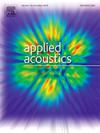Order-based beamforming to identify tonal noise sources from a variable speed array measurement
IF 3.4
2区 物理与天体物理
Q1 ACOUSTICS
引用次数: 0
Abstract
In rotating machinery, noise source identification plays a vital role in early-stage acoustic refinement. When machines operate at varying speeds, traditional beamforming techniques like frequency-based beamforming is no longer suitable, as the generated vibroacoustic phenomena are nonstationary. Order-tracking is a popular way to deal with such nonstationary regimes and can extract orders, which are time-varying phasors rotating proportionally to shaft speed. This paper introduces an Order-Based Beamforming (OBBF) technique, which performs beamforming on extracted orders by mapping complex envelopes at the array's microphones to the source complex envelope to localize and quantify sources causing tonal noise at variable speeds. The wealth of information provided by OBBF facilitates the construction of tonal acoustic radiation movies along the course of an order with each frame being a beamforming map, thereby enabling source characterization in space, time, frequency, angle and angular speed. The proposed technique is comprehensively detailed and verified both in numerical simulations and experimentally on an induction motor test bench.
求助全文
约1分钟内获得全文
求助全文
来源期刊

Applied Acoustics
物理-声学
CiteScore
7.40
自引率
11.80%
发文量
618
审稿时长
7.5 months
期刊介绍:
Since its launch in 1968, Applied Acoustics has been publishing high quality research papers providing state-of-the-art coverage of research findings for engineers and scientists involved in applications of acoustics in the widest sense.
Applied Acoustics looks not only at recent developments in the understanding of acoustics but also at ways of exploiting that understanding. The Journal aims to encourage the exchange of practical experience through publication and in so doing creates a fund of technological information that can be used for solving related problems. The presentation of information in graphical or tabular form is especially encouraged. If a report of a mathematical development is a necessary part of a paper it is important to ensure that it is there only as an integral part of a practical solution to a problem and is supported by data. Applied Acoustics encourages the exchange of practical experience in the following ways: • Complete Papers • Short Technical Notes • Review Articles; and thereby provides a wealth of technological information that can be used to solve related problems.
Manuscripts that address all fields of applications of acoustics ranging from medicine and NDT to the environment and buildings are welcome.
 求助内容:
求助内容: 应助结果提醒方式:
应助结果提醒方式:


